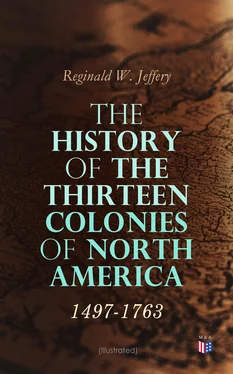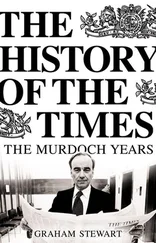Leonard Calvert, brother of the second Lord Baltimore, sailed to take possession in 1633, accompanied by two Jesuit priests and three hundred emigrants. These colonists were neither gaol-birds nor religious fanatics; they had been selected with great care and were well provided. One of the Jesuits, Father White, has left on record his Impressions in which he says that the colony was founded with a definite religious and educational purpose. "We had not come thither for the purpose of war, but for the sake of benevolence, that we might imbue a rude race with the precepts of civilisation, and open up a way to heaven, as well as impart to them the advantages of remote regions." 68When the settlers came to the place of landing they "beheld the natives armed. That night fires were kindled through the whole region, and since so large a ship had never been seen by them messengers were sent everywhere to announce 'that a canoe as large as an island had brought as many men as there was trees in the woods.'" 69From this moment and onwards the relations with the natives were always friendly. The small independent landowners being free from this danger, at first, lived happy and contented lives, but they were gradually crushed out of existence by large estate-holders working with gangs of indentured labourers.
The people of Virginia looked with some scorn upon their modern neighbours, and it was not long before a quarrel took place. The Isle of Kent lay in such a position off the coast that under Baltimore's patent it ought to have been included in the province of Maryland. But in 1625 the Virginians had settled there for trading purposes, and were determined not to be brought under the yoke of Baltimore's proprietorship. Two years after the establishment of Maryland, the Isle of Kent was under the rule of William Clayborne, a strong Protestant, a contentious man, who was described by his enemies as "a pestilent enemie to the wel-faire of that province and the Lord Proprietor." 70
Calvert, anxious to establish the rights of his brother, sent two ships to the Isle of Kent, and these were attacked by the crew of a pinnace belonging to Clayborne, lives being lost on both sides. The quarrel continued with so much fervour that it became merged in the greater struggle of the Civil War. Calvert was granted by the King letters of marque for privateering purposes, and he took good care to prey upon his enemy, Clayborne, whose friend Ingle had been furnished with similar letters from Parliament. Thus having placed the quarrel which was really personal under the banners of King and Parliament, the two rivals contended with each other.
The Parliamentary forces were, at first, successful; Ingle and Clayborne invaded Maryland, seized St Mary's, and Calvert was obliged to fly. But with assistance from Governor Berkeley of Virginia, he returned and drove out the Clayborne faction which had disgusted the people by its incapacity and greed. The quarrel ceased for a short time, owing to Calvert's death; but it was not long before it was renewed. Lord Baltimore appointed as his deputy William Stone, an ardent nonconformist and Parliamentarian, who repaid the Proprietor's generosity by leaguing with the people of the Isle of Kent. Traitor though he was, it is to be remembered that during his period of rule one good act was passed. Maryland was already celebrated for its toleration, but in 1649 it was still further enacted that a Christian was not to be "in any ways molested or discountenanced for or in respect of his or her religion, nor in the free exercise thereof." 71
For the peace of their minds and the preservation of their property Stone and the settlers acknowledged the Parliamentary commissioners, including Clayborne, who landed in 1652. They first displaced Stone, but realising that he was popular, and thinking that it would be advantageous for them, reinstated him. Stone, however, once more proved a trimmer, and sided with the Proprietor; his late followers deserted him and turned to Clayborne. On the establishment of the Protectorate in 1654 Lord Baltimore asserted his rights, claiming that he now held from the Protector Cromwell, and declaring that the commissioners' privileges had ceased. Clayborne and his companions were not the men to take such a rebuff as this. "It was not religion, it was not punctilios they stood upon, it was that sweete, that rich, that large country they aimed at." 72With this desire, according to a contemporary, Clayborne asserted his authority by disfranchising the Roman Catholics and forbidding the oath of loyalty to the Proprietor. William Stone, stung to resistance and filled with importance as the representative of Lord Baltimore, took up arms and was defeated by the Protestant party at Providence in 1655. Many of Stone's followers were executed, and their property confiscated; Stone himself was sentenced to death, but was reprieved. Clayborne's party now seemed triumphant, but the home authorities refused to bestow upon him the Isle of Kent, and within two years the Protector restored to Baltimore his proprietorship of Maryland. Trouble still continued, and in 1659 Josias Fendall, the Proprietor's Governor, so worked upon the members of Assembly that they claimed full legislative rights and complete independence of the Baltimore family.
At the Restoration the quarrel came to an end, and Lord Baltimore re-established his rights with nothing more than a mere show of force. Philip Carteret was appointed Governor, and during his term of office a mint was set up in the colony. He was succeeded in 1662 by Charles Calvert to the alarm of the Protestant inhabitants, who sent an extraordinary document to the Lord Mayor and London merchants entitled, " Complaint from heaven with a hue and cry and a petition out of Virginia and Maryland, to the King and his Parliament against the Barklian and Baltimore parties. The platform is Pope Jesuit determined to overthrow England with fire and sword and destructions, and the Maryland Papists to drive us Protestants to purgatory. " 73These, however, were purely imaginary troubles, and a more real one fell upon both Virginia and Maryland on August 27, 1667, when a terrific gale destroyed in two hours four-fifths of their tobacco and corn, and blew down 15,000 houses. On the whole Virginia suffered perhaps more than Maryland, but neither colony was really subject to such perils; and both, during the first fifteen years of Charles II.'s reign, enriched themselves as well as the Proprietor or the Crown by the fertility of their soil. This period of prosperity, however, gave way to one of unrest.
By the death of Cecil, Lord Baltimore in 1675, Charles Calvert, the late Governor, succeeded as heir to the family titles, estates and proprietorship of Maryland, the latter being placed under his deputy, Thomas Notley. The Proprietor was not at first upon the best of terms with the home government. He was severely reprimanded by the Privy Council for the imprisonment and assassination of a collector of customs. It is not hinted that Baltimore had any actual hand in this crime, but it is thought that he connived "at least ex post facto in his murder." No sooner had the Proprietor got over this difficulty, than he fell out with the settlers, who were caused much uneasiness in 1681 by the limitation of the franchise to those freeholders of 50 acres or those owners of other property of the value of £40. A spirit of unrest was therefore abroad, and there were not wanting those who were ready to snatch the opportunity and pose as patriots against the aggression of the Proprietor. Josias Fendall, who had already tried to deprive the Baltimore family of their rights, and who had now become an unworthy demagogue, leagued with John Coode, a clergyman, and revolted. The insurrection, as such, was short-lived. But exciting events were taking place in England, and Coode again seized his chance when news of the Revolution of 1688 drifted across the Atlantic. He placed himself at the head of the Association for the Defence of the Protestant Religion, and in 1689, pretending that he was serving William III., seized in the King's name the government of Maryland. The King bestowed some signs of favour upon this clever rebel, but his designs were soon discovered, and the government of Maryland was radically changed. In 1691 the colony was placed under the direct control of the Crown; the political rights of the Proprietor were annulled; the Church of England was established, and the Roman Catholics were persecuted.
Читать дальше












